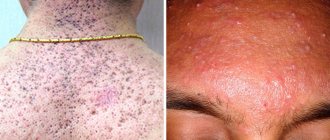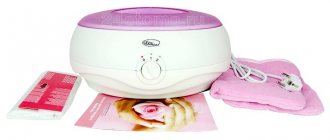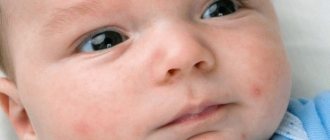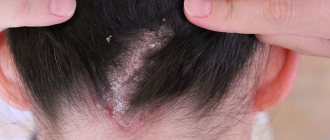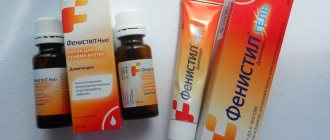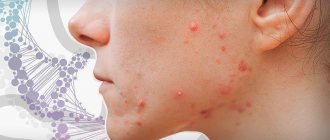Skin xerosis is an abnormal dryness of the upper layer of the skin caused by changes in the hydrolipid balance of the skin. It manifests itself as a dry, rough structure of the surface of the skin. The skin becomes cracked, inflamed, and infected. With the disease, the entire spectrum of pathological skin changes is observed: disturbances in sebum secretion, sweating, skin lipids, amino acid deficiency, and a feeling of discomfort. The condition is constantly accompanied by itching, which reduces the patient’s quality of life.
Causes
The main mechanisms for the development of dryness and flaking of the skin are a violation of its acid-base balance, poor functioning of the sebaceous glands, too frequent renewal of the upper layer of the epidermis and moisture deficiency in the epithelium.
The reasons may be: external influences, various diseases - both dermatological and general, and the general condition of the body. Of the external factors that have an adverse effect on the skin and cause dry skin, the most significant are the following:
- exposure to aggressive substances;
- chapping, hypothermia or overheating of the skin (for example, a sauna);
- improper skin care;
- exposure to ultraviolet radiation, especially in combination with weathering, or prolonged contact with an alkaline environment (for example, staying on the beach by the sea);
- regular exposure to hot or extremely cold water, especially chlorinated water.
Dry and flaky skin can be symptoms of the following diseases: allergic reaction; acquired, hereditary or congenital skin diseases, including psoriasis, seborrhea, eczema, atopic dermatitis, ichthyosis; diseases of bacterial, viral, inflammatory, hereditary and other etiologies. Dry and flaky skin may indicate the presence of: endocrine diseases (hyper- or hypofunction of the thyroid gland or adrenal glands, diabetes mellitus); problems with the digestive tract (gastritis, duodenitis, cholecystitis); metabolic disorders; some neurological ailments (migraine, autonomic-vascular dysfunction, neuralgia, neuroses, depression); damage to the endocrine system and other diseases requiring treatment. The most common cause of the development of xerosis is poor nutrition and, as a result, a lack of minerals and vitamins in the body. Spring peeling of the skin, often mistaken for an allergy, is in fact most often a manifestation of a lack of vitamins in the body. It is dull, dry and flaky skin that in most cases is the first symptom of vitamin deficiency A, E, B1 and C. Interestingly, a deficiency of vitamin B6 manifests itself on the contrary, with oily skin prone to acne formation. Dry hand skin may indicate a lack of vitamins A, E, B7 and D. Dry and flaky skin can also be caused by a lack of minerals (zinc, magnesium) and Omega 3 (polyunsaturated fatty acids).
Dry Skin Care: Feel the Difference
“Dryness” is usually understood as a combination of several factors: a feeling of tightness, skin that is rough to the touch, itching, dull appearance, increased sensitivity and flaking.
But this phenomenon may have different causes, which will require different approaches to treatment.
Dry skin type: lack of sebum
It is important to understand that we are talking about an innate property here. This skin has always been dry, since childhood, and will always be dry, not only on the face, but also on the body.
This type is genetically predisposed to insufficient production of sebum (sebum), the sebaceous glands are inactive, which means that the hydrolipid layer is very thin (or absent altogether), this is the cause of “chronic” dryness. A simple law of physics: the density of oil is less than the density of water, as a result the oil floats to the surface. The same principle works in our skin: oil (sebum) “covers” water, which constantly evaporates from the surface of the skin; the less sebum, the drier the skin.
The ability of the stratum corneum to adequately regulate water flow is measured using the transepidermal water loss index (TEWL index). If it is higher than normal, the skin will “dry out”. And although people with dry skin do not have a problem with the actual amount of water entering the upper stratum corneum from the lower layers of the epidermis, the absence of “oil” on the surface provokes increased moisture consumption.
Dry skin most often looks dull and gray, wrinkles and rosacea appear on it early. Many women with dry skin already in their 30s are upset because wrinkles become more pronounced day by day. These are the first clients in beauty clinics for the procedures of mesothreads, dermal fillers and Botox injections.
How to treat:
Prevention is the key to success. From all of the above, it follows that dry skin needs additional lipids (oil) to reduce water evaporation. If you cover the skin with something impermeable, the water content in the stratum corneum will increase quite quickly, but if you block the skin’s “breathing” (gas exchange), the protective barrier may be damaged.
In cosmetics, occlusive agents are used to form a semi-permeable film that allows the skin to breathe. Such agents differ in the strength of occlusion: the first on the list is petroleum jelly (reduces TEWL by 99%), look for it first in the composition if you have pathologically dry skin, followed by mineral oil (reduces TEWL by 40%), slightly weaker » natural waxes and their esters, lanolin, animal fats, vegetable oils, squalane and squalene.
Look for ceramides, jojoba, mango, shea butter, borage, beeswax and cetyl alcohol on the label. It’s good if the composition contains niacinamide (vitamin B3), it significantly increases the amount of fatty acids in the stratum corneum, which reduces TEWL by 20% in 24 days.
You can also use oil serums after washing, applying peels or toner, and if you also put a warm towel on for 10-15 minutes, this will increase the effectiveness of the procedure significantly.
Be careful:
You should avoid detergents (surfactants), soaps and other harsh chemicals that “remove” lipids from the surface of the skin. It is better to use cold cream or micellar water for cleansing. Powder cosmetics (loose powders, blush, shadows containing titanium, zinc, kaolin, etc.) due to their adsorbing properties can also worsen the condition of dry skin; it is better to apply makeup using “creamy” cosmetic textures.
Dehydrated skin: lack of moisture
Unlike genetically dry skin, here we are dealing with a temporary condition when the skin does not lack “oil”, but rather water.
Among the factors that can lead to loss of moisture and dehydration of the skin, the first place is seasonal weather changes: cold wind, rain, snow, the influence of which is aggravated by the “dry” indoor microclimate during the heating season. For this reason, skin care in autumn, winter and spring has its own characteristics, even if your skin type is not dry. And in the summer, “gentle” climate, the skin is vulnerable due to frequent exposure to the sun.
Smoking or a diet high in salt, caffeine, or other stimulants also increase dry skin.
In addition, people with oily or combination skin sometimes use sebum-regulating products too actively. Many people believe that skin “without an oily sheen” (read: without sebum production) is the healthiest skin, therefore, when they notice “excess”, they begin to use aggressive detergents and other products to remove even a hint of imperfection. This leads to the fact that not only the upper hydrolipid mantle is “washed away”, but also the extracellular matrix and lipids of the stratum corneum (lipid barrier) are damaged, so the TEWL index increases sharply.
“Drying out the skin” can be done with aggressive detergents (usually clear and well-foaming products), which wash out cholesterol and fatty acids from the skin. The sebaceous glands begin to produce even more sebum to replace the loss, resulting in the skin looking oilier than usual, but the fluid still evaporates and the feeling of tightness does not go away. Over time, the effect can spread to deeper layers (dermal dehydration), leading to cracks in the stratum corneum, as well as ptosis and deep wrinkles. Some dermatologists consider this condition to be the first step towards eczema.
The skin's natural defense, the lipid barrier, counteracts these negative factors.
formed by cells on the surface of the skin. His generally accepted model is the brick-and-mortar model, where cells are held together by a substance that includes cholesterol, fatty acids, and ceramides. This composition ensures waterproofness; it does not allow moisture to pass through from the outside, while at the same time not releasing it from the inside, thus maintaining the water balance of the skin. When the barrier is damaged, the skin can no longer protect itself.
How to treat: If the integrity of the barrier is not broken (skin tightness does not bother you for long), so-called humectants will help compensate for the lack of fluid in the stratum corneum
(humectants) - substances that bind water. Everyone knows very well, for example, about hyaluronic acid and glycerin - both of these substances work according to the same scheme, turning water into a “gel”, from which it is more difficult for it to evaporate from the surface of the skin. Humectants have the ability to attract moisture from the air (especially effective if the humidity is 80% or higher), however, at low humidity they can attract water from the lower layers of the epidermis and dermis, exacerbating “dryness”.
As a rule, such substances in products for dehydrated skin are combined with occlusive agents, this greatly increases the effectiveness of the product as a whole. If you use a serum with humectants, it is better to “cover” it on top with a cream that matches your skin type.
Look for the label: sodium PCA, glycerin, aloe vera, hyaluronic acid, arginin.
If the integrity of the barrier is compromised (you have been feeling tightness for a long time, your skin is rough to the touch and conventional products no longer help), professional products that imitate the natural lipid barrier of the skin in both composition and structure will be the most effective.
They must contain ceramides, fatty acids and cholesterol in a certain proportion. Such systems support and restore the skin barrier function by correcting the imbalance in the composition of intercellular lipids. Atopalm, Dove and La Roche-Posay have such products.
Be careful:
Avoid formulations with acids, peelings and scrubs; you should also avoid PEGs in cosmetics. Avoid products containing alcohol and foaming surfactants, as well as hot baths and chlorinated pools.
The trick is that dehydrated skin lacks water, and dry skin lacks oils. Your skin can be dehydrated, dry or dry and dehydrated, it can even be oily and dehydrated at the same time.
However, there is a general scheme for the use of cosmetics that is valid for both dry and dehydrated skin. Typically, after cleansing and toning, a moisturizing serum with humectants is applied, then an oil serum and, as a “finishing touch,” a moisturizing cream (give time to “absorb” each layer). This strategy is sure to bring quick results.
Tatiana Morrison
Photo thinkstockphotos.com
Products by topic: (face serum), (face cream)
Symptoms
Most often, dry skin is a temporary problem that only bothers you during a certain season, but it can last a lifetime. Symptoms of xerosis depend on your general health, age, where you live, and how much time you spend outdoors. Possible symptoms include:
- Feeling of tightness of the skin, especially after a bath.
- The skin is wrinkled and dehydrated.
- The skin looks rough instead of smooth.
- The itching is disturbing, sometimes very intense.
- Peeling of the skin - from slight to severe.
- Cracks in the skin, sometimes bleeding and painful.
- Redness of the skin, usually in limited areas.
Skin type test
A professional cosmetologist in a clinical setting can easily determine what type of skin you have using a device called a dermatoscope. You can try to determine your type yourself. There are several ways to do this.
Method 1
Clean your face and do not apply makeup. After two hours, notice how your skin has changed:
- Normal. The shade does not change, there is no feeling of tightness or greasy shine.
- Dry. Tightness or flaking, which can be eliminated with a rich cream.
- Combined. The T-zone and cheeks are shiny.
- Fat. It acquires shine over the entire surface.
Method 2
As in the first case, you need to wash your face and wait 2 hours without applying any makeup. Next, a thin napkin is pressed tightly to the face. Your type is determined by traces of sebum:
- Fat. Imprint of sebum on all areas.
- Dry. There are no stains left on the paper. Skin particles may remain.
- Mixed. Marks in the T-zone, sometimes also on the forehead and/or chin.
- Normal. Minimal traces.
Both of these methods are as unreliable as they are simple. It is important to understand that you can make a mistake and harm yourself with the wrong care.
Other leather characteristics
In addition to this division into types, there are other categories of types of epidermis. Cosmetologists highlight the skin:
Problematic. This type most often occurs during puberty, from fourteen to twenty-five years. Characterized by various inflammations, acne, etc.
Mature. It is characterized by noticeable age-related changes, the presence of wrinkles around the eyes and on the forehead, the appearance of nasolabial folds, and drooping of the facial contours (also called ptosis).
Sensitive. Allergic skin, prone to irritation, itching, burning.
Cooperose. It is distinguished by visible capillaries located close to the surface.
Treatment
Methods for moisturizing the skin are different and are largely determined by eliminating the source - the catalyst of the problem. If the cause is a specific disease, then treatment of dry skin of the body includes all the necessary measures that can stop the pathology, and hence remove its accompanying symptoms.
If the reason is different, then it is necessary to take measures to protect the skin from the negative influence of external irritants, which can be eliminated independently. It is necessary to keep the skin clean, but you should not overdo it with the amount of washing and taking baths and showers. Cosmetics for washing must be of high quality and match your skin type. You should use only high-quality, non-expired cosmetics. In winter, it is necessary to use protective creams. In everyday life, prefer clothes and shoes made from natural materials. This will protect against the occurrence of allergic reactions to artificial material and protect against thermal overheating of the skin. Anti-inflammatory agents must be used along with moisturizers. It is recommended to use anti-allergy medications or general health-improving medications internally, which will be prescribed by your dermatologist.
Dry patches with scales
Pink, raised, dry patches on the body and head may indicate psoriasis. With this dermatological pathology, raised plaques appear on the skin of a person - psoriatic papules. They protrude above the surface of the skin, cause intense itching and flake, and tend to spread and coalesce.
Psoriasis is a chronic autoimmune disease in which rashes are most often localized on the elbows, head, knees and groin. Dry pink spots covered with white scales are foci of chronic inflammation. Under the influence of internal autoimmune processes, epidermal cells divide several times faster than necessary. As a result, small flakes of dying skin cells are constantly separated.
Hygroscopic humecants
Hygroscopic humecants affect skin cells. These substances include: pyrrolidonecarboxylic acid, hyaluronic acid, collagen and lactic acid. The molecules of these substances are very similar to the skin. Hygroscopic humecants bind water molecules together and securely hold them in the layers of the skin. These are the most essential substances in the treatment of dry skin on the body. They also restore the level of moisturizing factor in the epidermis. The most powerful hygroscopic substance is hyaluronic acid, which is extracted from the skin of sharks and cockscombs. Just one gram of this substance can turn a liter of water into a gel. Therefore, cosmetics containing hyaluronic acid are very effective. Collagen also plays a big role in treating dry skin. This substance fills the intercellular space of the skin; it is capable of holding a huge amount of water, which exceeds its weight by 30 times.
Treatment of severe peeling hands
Common skin pathologies on the hands are treated with hormonal creams and ointments. The treatment regimen may include vitamins and antibiotics.
During the examination, the dermatologist will assess the condition of the skin, determine the cause and recommend additional measures that will alleviate the condition:
- take long, hot baths less often;
- moisturize the skin of your hands with oils;
- avoid soaps with an aggressive pH;
- use towels made of natural fabric.
General strengthening procedures promote rapid recovery.
It is important to normalize the diet and the diet itself, increase the body’s protective functions and improve metabolism. This is facilitated by physical exercise, acupuncture, massages, hirudotherapy, the effectiveness of which has been proven for skin diseases. August 16, 2021
Author of the article: dermatologist Mak Vladimir Fedorovich
Why does the skin need water?
Moisture ensures skin elasticity, firmness and nourishment of skin cells. The level of hydration depends on the condition of the upper layer of skin and the amount of sebum secreted. These two factors are responsible for moisture exchange. Fat and the moderate stratum corneum form a lipid film on the skin; this film prevents moisture from leaving the skin and the environment from greatly influencing the condition of the inner skin. The absence or weakening of the lipid film, caused by age or external aggressive environmental factors, leads to excessive evaporation of moisture, and therefore to dry skin. It also negatively affects blood microcirculation and skin ventilation. Due to the lack of the required amount of moisture, the skin becomes dry and flabby.
Sensitive skin
Sensitive skin is best described as “reactive” skin. This means that it reacts and changes character depending on its environment. Depending on how sensitive your skin is, it can react to everything from changes in temperature or humidity, the cosmetics you use, touch, and more. Many people confuse dry or irritated skin with sensitive skin, but in reality, sensitive skin may be oilier and suffer from impurities and breakouts.
Features of sensitive skin: it is thinner, lighter and more sensitive, with impaired barrier function and a large number of capillaries. The skin has an uneven structure. Requires special care and caution when using new cosmetics. People with sensitive skin who are more exposed to the sun develop eczema or rosacea.
Rosacea on sensitive facial skin
If your skin describes more than one of the following, you probably have sensitive skin:
- Varies greatly from season to season;
- Makeup and grooming are often associated with acne;
- Tends to become hot and red when touched or physically affected (such as from cleansing masks or facial scrubs);
- Lots of redness on the skin in general;
- Allergy, rash, itching, dryness;
- Flushes easily from heat or cold;
- Not all means are suitable. Often experiences adverse reactions when using new products;
- Unpredictable and can change greatly from day to day.
Care - basic rules
There are recommendations both for specific types and general ones. For any skin, it is important to carry out daily care in three stages:
Cleanse. Washing with any product. Twice, morning and evening. Prepares the epidermis for the second stage. It is better to carry out with water at room temperature.
Tone. Residues of cleanser are removed and pores are narrowed. A tonic is used.
Moisturize. The cream is necessary to maintain the skin's natural moisture level. It is best to choose a cream with ultraviolet protection (SPF from 30).
Irritated skin
Irritation can occur in all skin types and manifests itself in different ways from time to time. There are many reasons for this: temperature changes, exposure to the sun, food, diet, touch, bacteria and much more.
If one or more of the following descriptions apply to you, this is a sign that your skin is currently irritated:
- The skin suddenly turns red;
- Suddenly becomes warm;
- There is itching, tingling or burning;
- Suddenly a lot of pimples appear - even where there are usually none.
What is the difference between skin type and skin condition?
Before choosing products and skincare routines, you need to know two basic concepts: skin type and skin condition.
Although there is much overlap between these two concepts, they differ on one central point: we are born with our skin type, and this characteristic is more or less stable throughout life, while skin conditions often change and are treatable.
Sounds a little confusing? Let's take an example: Sensitive skin is a skin type because a person is born with a reduced tolerance to touch, temperature changes, changes in humidity, and even sometimes hypersensitivity to certain ingredients.
On the other hand, irritated skin is a condition and not a type because it is a temporary condition and can be corrected with proper care and diet. So you can have sensitive skin without irritation. Consider, for example, sunburn; This is a type of skin irritation that can be relieved by using after-sun products and stopping sun exposure.
Sunburn
Why is this important to know? Many people end up misjudging their skin by confusing concepts. This means they choose products that are not effective for their skin or may even make it worse.
A classic example: patients often think they have oily skin, but in reality they are mistreating it. You can tell about improper care by the fact that the skin looks oily on the surface, but when you try to wrinkle your nose or forehead, it turns out to be wrinkled and dry. This condition is associated with the use of the wrong products, such as drying products for oily skin, having a completely different type. This causes the body to defend itself by increasing sebum production. If you switch to proper care, this condition will disappear.
What determines skin type and condition?
Skin type is genetically determined by our parents and can be measured by the level of sebum production. Overactive sebaceous glands lead to oily skin, while underactive sebaceous glands cause dry skin. Can also be determined genetically: skin reactivity, capillary activity and sensitivity.
The condition of the skin varies depending on external influences and factors such as surgery, medications, stress, environment and disease.
Film-forming humecants
Film-forming humecants include glycerin, fats, waxes and mineral oils. They form a protective film on the surface of the skin and thus prevent excessive evaporation of moisture. Glycerin can be called the strongest of the film-forming humecants, but it not only retains moisture well, but also stimulates the process of creating young skin cells. A large number of new cells maintains water balance in all layers of human skin.
Also, hexahydric alcohol sorbitol has special properties, which not only perfectly moisturizes the skin, but also forms a film that prevents moisture evaporation.
Another popular remedy for combating dry skin is linoleic acid, which, in addition to creating a waterproof film, regulates the permeability of the epidermis.
If you notice symptoms of dry body skin, consult a dermatologist, because this disease may be caused by more complex and dangerous diseases.
Normal skin
Normal skin is not the most common type. It has a normal level of moisture and oil - this is the skin in balance. This skin type rarely experiences really big problems: its condition may vary, but in general it is easy to maintain.
Features of normal skin: Has a healthy glow and color, without large pores, wrinkles or fine lines. The skin is soft, moist, with a smooth and fine structure.
If your skin is uniform and balanced, rarely suffers from oiliness, breakouts or dryness, and you have no adverse reactions to various skin care products, congratulations on winning the genetic lottery and having normal skin.
Normal facial skin type
Although this type of skin is very easy to care for, unfortunately, it is characterized by signs of premature aging.
If your skin describes more than one of the following, you probably have normal skin:
- Looks completely normal, even without scrub and creams;
- Beautiful and soft;
- The skin around the nose may sometimes be a little shiny;
- Most cosmetics are suitable;
- Pimples and blackheads are rare, but they do happen from time to time;
- The pores are not very visible;
- Skin changes slightly from season to season;
- Makeup does not come off or smudge.
Review of CeraVe cosmetic products for dry skin
CeraVe lotions and creams for dry and very dry skin are formulated with ceramides and hyaluronic acid. These components are especially important for dry skin, as they help to naturally strengthen the skin's hydrolipid barrier and protective functions, as well as its ability to attract and retain moisture.
CeraVe Moisturizing Facial Lotion
For what skin types: normal to dry skin
Active components:
- ceramides;
- hyaluronic acid;
- phytosphingosine;
- cholesterol;
- glycerol;
- niacinamide;
How it works on dry skin: CeraVe face lotion has a pleasant, light texture that helps intensively moisturize the skin throughout the day, maintaining and strengthening the protective barrier. Niacinamide, which is part of the lotion, additionally helps to soothe the skin, reducing discomfort.
Moisturizing lotion
For dry to very dry skin of the face and body
Provides 24 hours of hydration, restoration and strengthening of the protective skin barrier.
More details
Moisturizing facial lotion CeraVe SPF 25
For what skin types: normal to dry skin
Active components:
- ceramides;
- hyaluronic acid;
- phytosphingosine;
- cholesterol;
- glycerol;
- niacinamide;
- tocopherol
How it works on dry skin: CeraVe SPF 25 facial lotion helps to achieve long-lasting hydration of the facial skin, maintains and strengthens the hydrolipid barrier and protective functions of the skin. In addition, it has a broad spectrum of filters, which helps protect dry and potentially photoaging-prone skin from UVA and UVB sun rays.
Moisturizing facial lotion SPF 25
For normal to dry skin
Provides effective broad-spectrum protection against UVA and UVB sun rays and intensely hydrates skin for 24 hours.
52 ml
More details
Moisturizing cream for face and body CeraVe
For what skin types: for dry and very dry skin of the face and body
Active components:
- ceramides;
- hyaluronic acid;
- phytosphingosine;
- cholesterol;
- glycerol
How it works on dry skin: CeraVe face and body moisturizing cream is designed for daily care, hydration and restoration of dry areas of the face and body. It helps to attract and retain moisture in the upper layers of the epidermis, helps restore the protective functions of the skin and strengthen its hydrolipid barrier.
Moisturizing cream
For dry to very dry skin of the face and body
Provides long-lasting hydration throughout the day, restoring and strengthening the protective skin barrier.
More details
Prevention of dry body skin and moisturizing methods
When the first signs of dry skin appear, further development of this disease should be prevented. To do this, just follow some rules:
- Skin that is naturally dry must be moisturized with cosmetic creams that contain lecithin, collagen and propolis. Creams containing hyaluronic acid and other vitamins and minerals will also help. But moisturizing creams should not be overused, since with frequent use the skin will completely lose its ability to retain moisture on its own;
- People with a predisposition to dry body skin should treat it more carefully and not use aggressive scrubs. After water procedures, you should lubricate your body with a rich cream;
- Dry skin, in addition to moisturizing, must be nourished with useful substances. And remove exfoliated skin from the body;
- Also equally important is the correct selection of clothing and shoes; it is best to wear shoes only made from natural materials, and clothing should not contain large amounts of synthetics, especially underwear;
- Use humidifiers in the house, and in the car it is better to set the climate control to 85% humidity.
Contaminated skin
The condition is characterized by open and closed comedones (blackheads) and blockages beneath the surface of the skin. The skin has an uneven surface.
Contaminated skin with closed comedones
The black color of acne is oxidized sebum, not dirt. The second type of blockage, a pimple, is located on the outside of the pore and is often yellow in color. You probably tried to squeeze them out, and saw that the contents were a yellowish liquid. The final type of blockage is a pimple that sits under the skin, and it tends to be very painful and uncomfortable and also takes longer to heal.
If one or more of the following descriptions apply to you, this is a sign that your skin is clogged:
- Small blackheads around the skin, mainly located around the nose and cheeks;
- Swollen pimples with a yellow “head” around the face. They vary in size and usually occur on the forehead, around the mouth and near the nose;
- You experience uncomfortable, swollen, and painful pimples that sit under the skin and can be painful.

